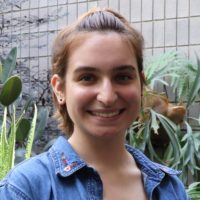
“Exploring the Biolistic Gene Transfer Approach for the Model Hornwort Anthoceros agrestis“
Project Summary:
Approximately 500 million years ago the first algae washed ashore and began the land plant evolution. The first land plants were nonvascular plants called bryophytes. The bryophyte clade encompasses mosses, liverworts, and hornworts. Although research on mosses and liverworts is growing abundantly, little research focuses on hornworts. Anthoceros agrestis is a model species for hornworts that can be used to understand the unique characteristics of hornworts in addition to the mechanisms of evolution in land plants. Pyrenoids are one of these characteristics and have the potential to be implemented into crop plants. Pyrenoids are compartments within algae and hornwort chloroplasts that contain a key enzyme for photosynthesis called Rubisco. These compartments have a mechanism for concentrating CO2 50 times more than other land plant chloroplast which leads to a much more efficient Rubisco and photosynthesis altogether. Introducing the genes involved in developing pyrenoids into crops could lead to greater efficiency and greater yield. Improving crops to sustain growing populations and providing for the underserved are significant matters that can be addressed by diving into hornwort characteristics. Genetic tools such as gene transformation and gene editing are vital for identifying the genes involved in pyrenoids, however, these tools have yet to be routinely implemented in hornworts. We are investigating the biolistic method of gene transfer by creating a protocol that is specific to hornwort tissue. The aim of this project is to optimize the biolistic gene transfer method in Anthoceros agrestis in order to consistently and efficiently perform genetic transformation experiments.
My Experience:
This summer I learned about what it is like to be a full-time researcher which is not something I could learn from my school. I learned new lab techniques that I can bring back to my lab at home, but more importantly, I learned how to set up an experiment and ask scientific questions. Throughout my interactions this summer I also learned skills dealing with interpersonal relationships with mentors, PIs, and other researchers in my lab. I know what to look for in a lab that I can work well with. The information I gained about grad school and the grad school application process I will take with me when figuring out my next steps.
